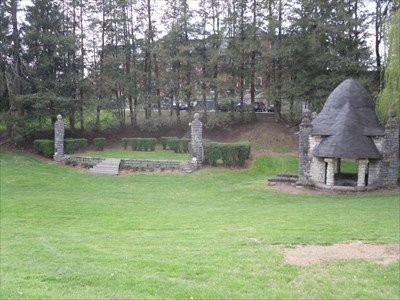The Spring House and Amphitheater
Introduction
Text-to-speech Audio
Originally located in Tiprell, Tennessee, Lincoln Memorial University students moved the Spring House to the Lincoln Memorial University campus in the 1930s. A few years after moving the Spring House, LMU students once again moved stones from Tiprell to construct the adjacent amphitheater.
Images
The Spring House as it appears in the present.

Backstory and Context
Text-to-speech Audio
From Lincoln Memorial University's 1950 Alumnus Magazine, by Class of 1950 alumnus James G. Smith (one of Charlie J. Smith's sons):
It was during the summer of 1936 that the Spring House was built in what is known as the bowl on the campus of Lincoln Memorial University. The Amphitheater was built near the Spring House in the summer of 1937. The builder was Charlie J. Smith, a contractor from Cumberland Gap.
The Spring House was moved from the little village of Tiprell which is about two miles south o Cumberland Gap near the Southern Railway tracks. Mr. Smith tore down the Spring house at its location one stone at a time. He made a derrick from a poplar tree with rope pulleys to move the large stones and loaded them in a flatbed Ford truck provided by Mr. H.K. Ryder, foreman of construction at LMU.
Mr. Smith with his eleven year old twin sons, Ben and Jimmy, usually walked from Cumberland Gap through the little tunnel to the LMU campus early every morning during the summer months of 1936 to work on reconstructing the Spring House. They followed the same routine in the summer of 1937 to reconstruct the Amphitheater which was also moved from Tiprell. The twins mixed the mortar in a six-foot-long box and carried the smaller stones in a wheelbarrow with a steel wheel while their father and Mr. Gordy Campbell, a mason from the Baccus community near Tazewell, patiently laid the stones in place. Mr. Campbell drove a 1932 A-model Ford automobile and the days that he worked he would drive Mr. Smith and the twins back to Cumberland Gap late in the evening.
The hot summer days seemed long, but it was a pleasure to see lunchtime come when Mr. Smith and his sons would walk over to the "Hunk Stand" and have one of Mrs. Jones' delicious five-cent hamburgers with a five-cent six ounce Coca Cola and a fifteen-cent pint of Swifts Neapolitan ice cream.
During the laying of the stones on the columnn to the right of the main entrance, Mr. Smith had a fall from the ten-foot scaffolding resulting in a torn shirt and a badly bruised shoulder; however, he climbed back up and started laying stone again. It was in that same columnn that Mr. Smith placed a letter signed by him and his sons which give the history of the building of the Spring House. The amphitheater also has a letter which was signed by Mr. smith and his sons placed in the electrical conduit of the right columnn giving the history of when it was built and by whom.
The round stones on top of each columnn of the Spring House and the Amphitheater were chiseled by Mr. Smith from large limestones in the quarry near the big Louisville and Nashville Railroad tunnel under the Cumberland Gap. The Senior class of 1936, with Kluck U. Berkau as President, sponsored the building of the Spring House and the Senior class of 1937 along with Earl Hobson Smith, Associate Professor of English and Speech, sponsored the building of the Amphitheater.
In 1925, a few years before building the Spring House and Amphitheater, Mr. Smith had built the concrete LMU letters which are so prominently in view as one drives by the beautiful campus of Lincoln Memorial University.
Sources
Hess, Earl. Lincoln Memorial University and the Shaping of Appalachia. Knoxville, TN: University of Tennessee Press, 2011.
Page, Bonnie and Cindy Stephenson. Lincoln Memorial University (Memories and More). Harrogate, Tennessee: PrintOne, 2001.
Sweet, Natalie. Images of America: Harrogate and Cumberland Gap. Charleston, South Carolina. Arcadia Publishing, 2014.
Suppiger, Joseph E. Phoenix of the Mountains: The Story of Lincoln Memorial University. Harrogate, TN: Lincoln Memorial University Press, 2001 (originally published in 1977).
Page, Bonnie and Cindy Stephenson. Lincoln Memorial University (Memories and More). Harrogate, Tennessee: PrintOne, 2001.
Sweet, Natalie. Images of America: Harrogate and Cumberland Gap. Charleston, South Carolina. Arcadia Publishing, 2014.
Suppiger, Joseph E. Phoenix of the Mountains: The Story of Lincoln Memorial University. Harrogate, TN: Lincoln Memorial University Press, 2001 (originally published in 1977).
